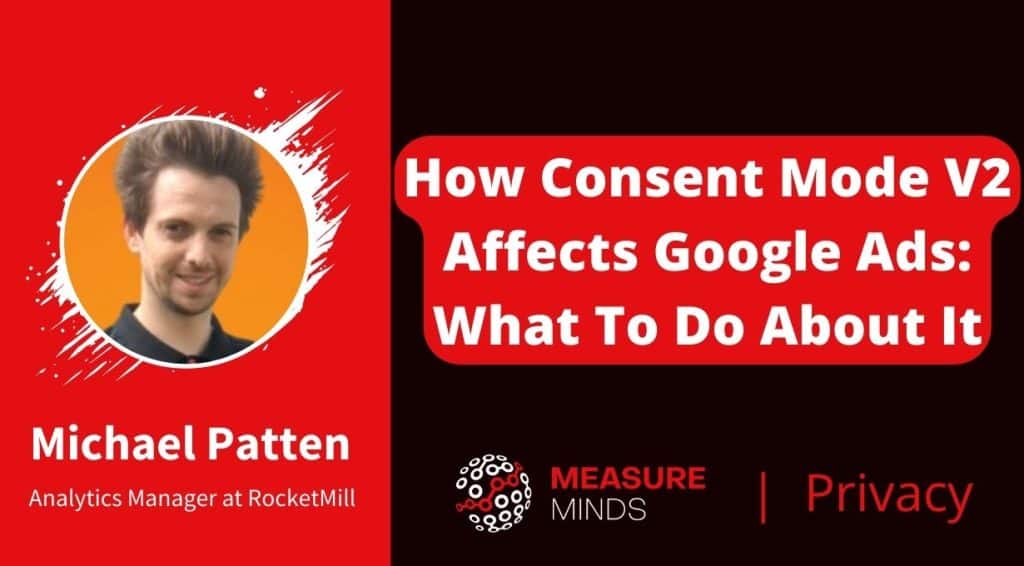
How Consent Mode V2 Affects Google Ads: What to do About it
The introduction of Consent Mode V2 by Google is designed to ensure compliance with evolving regulatory standards while preserving essential functionality in ads.
Understanding the implications of Consent Mode V2 is crucial for advertisers aiming to maintain effective ad strategies amidst changing privacy regulations.
This is a webinar write-up of Michael Patten’s talk at Privacy4Marketers. You can get the slides here. You can purchase the recordings (8 in total) or get them for free by signing up to a paid Cookiebot plan using our referral link. Just make sure to send a screenshot of the billing confirmation to william@measuremindsgroup.com.
What is Consent Mode V2?
Consent Mode V2 is a method of understanding a user’s consent to advertising cookies. It is a response to the Digital Markets Act (DMA) requirements.
This framework introduces two new parameters, Ads User Data and Ad Personalisation, to facilitate compliance with data privacy regulations and ensure seamless ad functionality.
To summarise briefly. A key difference between Consent Mode V1 and V2 is that NOW, when a user lands on a page, consent status must automatically be set to denied. Then when consent is accepted by the user, the consent status is set to granted.
Before, if a user didn’t specify consent, a website could still track information about the user.
What is the Digital Marketers Act?
Not to be confused with the Digital Services Act (DSA), the Digital Markets Act (DMA) represents a significant legislative development in digital governance, emphasising user control and privacy protection.
It introduces the concept of gatekeepers, targeting large data processors, and aims to regulate tech giants’ dominance in digital markets.
Compliance with the DMA is essential for businesses operating within the European Union to demonstrate adherence to regulatory standards and safeguard user privacy rights.
What is the Digital Services Act?
Operating alongside the DMA, the Digital Services Act (DSA) addresses broader issues such as transparency, online safety, and deceptive design practices.
By combatting manipulative tactics like coercive cookie consent practices, the DSA seeks to enhance user trust and mitigate potential privacy risks associated with online services.

Adhering to the DSA complements efforts to comply with data privacy regulations and foster a safer digital environment for users.
New parameters in Consent Mode V2
Ads User Data – controls whether user data can be sent to Google for advertising purposes.
Ad Personalisation – controls whether advertisers have permission to use user data for personalised marketing campaigns such as remarketing.
The addition of these parameters within Consent Mode V2 underscores the importance of user consent in ad targeting and measurement.
These parameters are critical in processing user data while enabling features such as enhanced conversions and remarketing.
Why do I need to implement Consent Mode V2 on my website?
To put it briefly, because it’s illegal for Google or you to collect data if you don’t. Therefore, Google will not allow you to collect or share user data with anything. Which will essentially nullify your analytics. Big no, no.
Google may stop you from using Google Ads and, eventually, Google Analytics altogether.

How does this affect smart bidding in Google Ads?
Let’s look at Smart bidding. Depending on your current setup, it’s going to have different levels of impact.
If you’re moving from Consent Mode V1 to the advanced version of Consent Mode V2, the impact to smart bidding is going to be low. You’re simply going to lose what we assume is cookieless modelling features relating to Ads personalization and Ads user data. But otherwise, all signals continue as usual.
When you’re moving from Consent Mode V1 to the basic version of Consent Mode V2, you’re going to lose cookieless modelling. So if you trained smart bidding solutions on cookieless modelling and suddenly it gets cut off, there might be some disruption to performance.
The third option where you haven’t had consent mode before, you’ve simply just used your CMPs consent logic to control tags firing should be low impact. In fact, supplying the new cookieless conversion modelling could provide a performance boost.
It’s number four where you should exercise the most caution. Where you haven’t had a CMP or Consent Mode setup and you’re now setting it up. You will be unable to track 100% of users as you could before. This is going to cause disruption because your smart bidding is going to be used to getting 100% of all collected data.

How to optimise your smart bidding for Consent Mode and GA4
Michael did a talk for us at a previous conference on how to optimise Google Ads with GA4. You can find the recording below:
Much of the same applies still.
The more robust learning data you can consistently supply your smart bidding strategies, the more effective it is at generating efficient conversions.
There are 4 elements of your smart bidding machine learning strategy that need consideration and input for an optimal output. Below is an image showing the 4 categories and the elements within them that ideally should be supplied.
See below we’ve crossed out enhanced conversions under cookieless data because as part of the Ads User Data parameter, that will be denied by default.

But it is not just a cookieless solution, it’s good at providing cross-device tracking as well. So that then gets refiled under the accuracy heading for those that opt-in to be tracked traditionally, via cookies.
You might not be able to do all of these things for your ads account, there might be limitations in place. But maximising these is the key to achieving great results from your smart bidding.
However, if you don’t have Consent Mode V2 in place by the March deadline, you can pretty much count out three of those four categories.

Focusing purely on machine learning, you’ll have to rely on the use of portfolio bidding, where you can group similar groups or campaigns together so they can share learnings rather than applying bidding strategies at a campaign level.
Put a portfolio bidding strategy in place and don’t keep changing the targets or adding and removing campaigns. At least for its initial learning phase, because that will disrupt things.
How to test the setup of Google Ads features
You can check the setup status on a page in your conversion settings. I’d recommend doing this even if you’ve had these features installed by someone else. Always verify your setup is working.

How to implement Consent Mode V2
Let’s compare the Basic and Advanced setups of Consent Mode V2.
Basic Consent Mode V2 implementation
In the Basic setup, if a user agrees to cookies, your website will function as usual in collecting user data. However, if a user declines cookie consent, your site won’t gather any data from them.
While this ensures full compliance with the DMA, it also means you won’t benefit from the user’s site visit unless they voluntarily provide their data through a form.
To implement Basic Consent Mode V2, you’ll need a consent management platform (CMP) to establish a cookie banner and manage user consent. It’s preferable to use a Google-certified CMP to ensure compatibility with Consent Mode V2.
Then, update your website so that Google Analytics 4 tags (and other data collection/tracking tags) aren’t activated if a user rejects cookies.
Advanced Consent Mode V2 implementation
Advanced Consent Mode V2 offers more flexibility regarding user consent to cookies. Upon the user’s acceptance or rejection of cookie tracking, the tags will be adjusted based on their consent choices. If consent is given, marketing tags are fired apropriately.
If consent is denied Google still gathers anonymous, cookieless information from the user while remaining compliant with privacy regulations.
Google can then utilise this data alongside conversion modelling to still paint a fuller picture of the user’s activity whilst adhering to user privacy guidelines.
There are two methods to set up Consent Mode V2, with the simplest being configuring it through a consent management platform.
Alternatively, you can set up Consent Mode V2 via GTM. However, these approaches require more advanced technical expertise. Hence, if you prioritise swift implementation, sticking with a CMP is advisable.
Advanced vs Basic Consent Mode:

Opting for the advanced version of Google Consent Mode is advantageous because it offers valuable modelling data that isn’t accessible with the basic version alone.
Recommendations for Consent Mode V2 compliance
To navigate the complexities of Consent Mode V2 and ensure compliance, advertisers should prioritise the following strategies:
- Prompt implementation: Advertisers need to prioritise and implement Consent Mode V2 NOW!
- Smart bidding optimisation: Maximising smart bidding effectiveness is crucial for achieving optimal results. Advertisers should provide robust learning data to their smart bidding strategies, enabling them to adapt and optimise performance effectively.
- Supplementing machine learning: Advertisers should explore supplementary
measures to enhance machine learning capabilities. Leveraging additional features and product offerings can augment smart bidding strategies and improve ad performance. - Legal compliance: Adhering to legal regulations is non-negotiable. Advertisers should seek legal advice to ensure their practices align with data privacy regulations and industry standards.
What are other ad networks doing regarding consent
Beyond Google, other ad networks and platforms are also adapting to evolving data privacy regulations. Meta, LinkedIn, Amazon, Microsoft Ads, and TikTok are implementing various strategies to address user consent and enhance transparency. Advertisers must stay informed about these developments and adapt their strategies accordingly.
As far as we know…
Meta
Meta providing more dimensions and metrics within the ads reporting platform to demystify historically confusing parts. I also recommend using the Facebook conversions API to capitalise on data accuracy.
LinkedIn are giving controls to LinkedIn users within the European Economic Area to say what they’re happy to receive or not receive. So rather than being defined by the websites they’re visiting, it’s actually defined by the users who have profiles on LinkedIn as to what they’re happy with.
Amazon
Similarly to LinkedIn Amazon are going to add new explicit consent controls within Amazon user accounts.
Microsoft ads
Microsoft are bringing out their own consent mode, which is currently in beta. And I think applies to both Microsoft ads and Microsoft clarity. Just the one ads_strorage parameter so far.
But remember that, strangely, Microsoft ads apparently isn’t in scope of Microsoft’s gatekeeper status. And note that it doesn’t use the data layer like Google, it uses the UETQ array. It’s relatively easy to hook up still, but it’s an extra consideration to be checking moving forward.
TikTok
TikTok chose a vastly different approach; they appealed their status as gatekeeper and that appeal was denied. So we’re all interested to hear what they do next.
In short…
Implement Consent Mode V2 now. And be prepared for the effects it may have on your smart bidding as outlined above.
Stay ahead of regulatory changes and maximise the effectiveness of your advertising campaigns with MeasureMind’s expert Google Ads management services.
Our team specialises in navigating complex frameworks like Consent Mode V2, ensuring your ads remain compliant while delivering exceptional results.
About Michael Patten
With over 9 years of agency-side experience in paid media, data and analytics, Michael is a well-rounded data expert. He combines a healthy dose of left and right-brain thinking with out-of-the-box ideas to deliver clients tailor-made solutions.
With a passion for problem solving and skill for demystifying data, he helps businesses of all shapes and sizes make sense of online user behaviour to create enhanced, actionable insights.
Find him on LinkedIn.

- How to Blend GA4 & UA Data Using BigQuery & Looker Studio - 12/07/2024
- How to do a Google Analytics 4 Audit & Mistakes to Avoid - 10/07/2024
- How to Backup & Visualize GA3 Data for Free - 27/06/2024